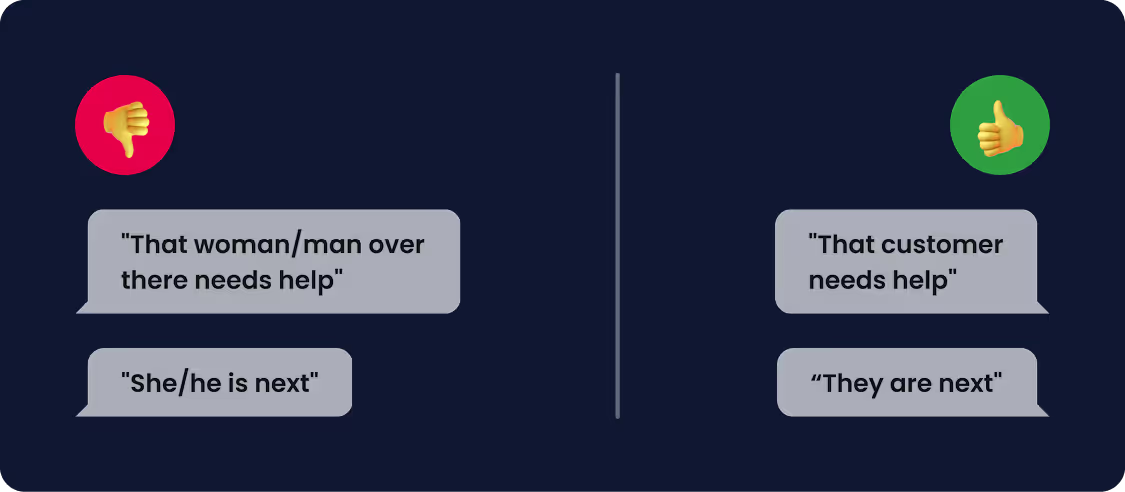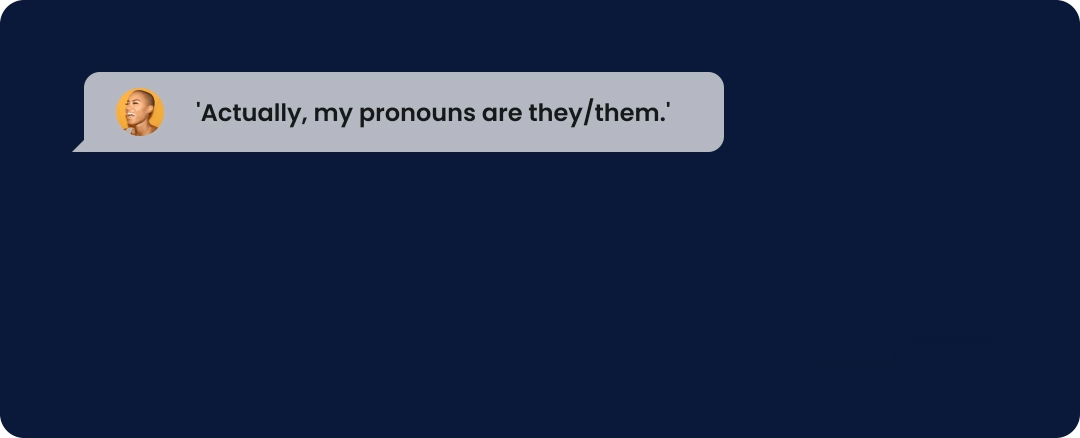How can retail employees create a more inclusive environment for their customers?
What is an inclusive environment in retail, and how can gender neutral language help us get there?

In this guide to inclusivity and gender neutral language in retail, we’ll explore how those working in the industry can make their shop safe, fun and welcoming for customers and each other.
Working a job in retail can be high-pressure, fast-paced and occasionally (okay, often) stressful.
When you have a full shop, a queue of customers waiting and an explosion of various products that need organising, it’s hard to have the presence of mind to adapt your language or the way you speak.
Gender neutral language is a small thought that can make a huge impact. If you haven’t explored this topic before, Thrive is here to illuminate you.
What does inclusivity in the retail industry really look like, and how can gender neutral language help us get there?
What is gender neutral language?
Gender neutral language is the practice of making sure the way you talk to or about other people avoids assumptions about their gender identity. This covers anything from their pronouns, to how you talk about what they’re buying, to the way you greet them.
Why is gender neutral language important?
If you’ve never had to think about it, it might feel a bit clunky or different to use gender-neutral language. We’re so used to the traditional way of doing things, breaking away from it can present a whole new host of challenges.
But it’s so important. By erasing assumptions and preconceptions about who someone is based on their appearance, you make your shop a more accessible, happy place for your customers and colleagues - no matter their identity.
How do you use gender neutral language in a retail environment?
Gender neutral language can take many forms. It’s not just about using gender neutral pronouns, although that is part of it - so let’s start there.
Gender neutral pronouns
Pronouns have become quite the hot button ‘issue’ over the last few years.
With more awareness and understanding, there naturally comes more misunderstanding about a topic. This has created a lot of conflict and discord, but it doesn't need to be complicated. It is, in fact, a very simple concept.
Pronouns, in a very literal sense, are a subclass of nouns. They are the way you refer to someone else, yourself, or a group of people, in place of a name or noun.
.avif)
When we talk about gender neutral pronouns, we are talking about avoiding assumptions rather than choosing to use ‘he/him’ or ‘she/her’ based on someone’s outward appearance.
Perhaps you’ve noticed there’s quite a lot of confusion around the use of the ‘they/them’ pronouns for an individual, as opposed to a group of people.
Despite popular belief - and thinly-veiled concerns for grammar - ‘they’ has been used as an individual pronoun for literal centuries.
That is not an exaggeration.
The first known use of the pronoun ‘they’ for an individual was in a 1375 poem by Guillaume de Palerme, firmly putting to bed the claim that this is a new phenomenon. We may be talking about it more now, but ‘they’ has been used in this capacity for over 600 years. It is, no matter what Candace Owens tries to tell you, grammatically correct.
Outside of the context of 14th century French romantic poetry, we use ‘they/them’ on an individual basis in our everyday lives - perhaps without even realising it.
Think about when you find a belonging that has been left behind by someone in a cafe or restaurant. You don’t say, ‘Oh, someone left her keys here,’ automatically assuming the owner’s gender. You say, ‘Oh, someone left their keys here.’ You are referring to one individual person, but using ‘they’ because you don’t know their gender.
It should be no different when the person in question is standing in front of you. Assume that you don’t know anyone’s gender - because you don’t.
So how can you put this into practice as a retail employee?
Avoid saying things like, “That woman/man over there needs help,” or “she/he is next.”
Gender neutral versions of this would be, “That customer over there needs help,” and “they are next.”

Remember that they/them is not the only gender neutral pronoun - there is a full list of different gender neutral pronouns that people might prefer to use. But in a retail setting where you don’t personally know the customer, they/them is a good place to start.
Don’t make assumptions about people’s purchases
Another way to create a more inclusive retail environment is to avoid making assumptions about someone’s purchases.
If someone who you wouldn’t ‘expect’ to be shopping in the women’s section is looking at dresses or skirts, don’t automatically assume that they’re buying a gift for someone else. Clothing, sports goods, workshop tools, Barbies, and makeup have no gender despite their stereotypes.
Greeting customers in a gender neutral way
We’re all well-accustomed to being greeted with the ubiquitous “Hi guys,” even if you are not a guy - or “Hi ladies.”
The impulse to use these terms is understandable - they’re comfortable and friendly. But they assume something about the group you’re greeting.
Instead of these gendered phrases, you can use:
“Hi folks, welcome to the shop.”
“Good morning, welcome to the shop.”
Practice makes perfect
If you’re finding it hard to adjust, you’re not alone.
From birth, we’re ingrained with assumptions and preconceptions about who we are, what we should like and who we should love based on our perceived gender.
“Boys don’t play with dolls.”
“Girls don’t play football.”
It’s inescapable, even as children - and then it follows us into adulthood. But through consistent and gentle practice, we can recalibrate the way we think and talk about ourselves and other people. You can shift those ingrained assumptions that you make about others. In fact, you can remove them altogether.
By consistently making an effort to use gender neutral language, it becomes embedded naturally within your day-to-day vernacular until you don’t even necessarily notice you’re using it. Exactly like the gendered language that we’re now trying to unlearn.
What if I get it wrong?
Well, you don’t have to take one of those Captcha tests to prove you’re not a robot - because you’re a human, and humans make mistakes.
If someone tells you that you’ve made a mistake about their gender, simply thank them, correct yourself, and move on.
Don’t make a big deal of it.
Don’t make it about yourself.
Don’t try to make excuses.

You made an assumption; it turns out you were wrong. It happens to everyone.
The true opportunity to either make a mistake or make amends comes in the next few moments, when you decide how to handle it.
Thrive at Ted: High end retailer uses Thrive Content to teach employees about gender neutral language
Thrive customer Ted Baker understands the importance of gender-neutral language, thereby making their stores a safe and inclusive place.
Noticing a gap in their content offering around the subject, they utilised Thrive Content to help them fill it. They now have a library of resources about inclusive language, arming their staff with the knowledge they need to make everyone feel welcome.
They’ve labelled the practice ‘Tactical Talk’ - an umbrella term that encompasses the concept of using inclusive language and erasing assumptions.
Interested in this service for your own business? Check out Thrive Content here - and if you’re looking to learn more about L&D within the retail space, tune into our webinar: Why forward-thinking L&D leaders are moving to Thrive.


.svg)